9,250 views

Line Protection With Distance Relays
Distance relaying should be considered when overcurrent relaying is too slow or is not selective. Distance relays are generally used for phase-fault primary and back-up protection on subtransmission lines, and on transmission lines where high-speed automatic reclosing is not necessary to maintain stability and where the short time delay for end-zone faults can be tolerated.
Overcurrent relays have been used generally for ground-fault primary and back-up protection, but there is a growing trend toward distance relays for ground faults also. Single-step distance relays are used for phase-fault back-up protection at the terminals of generators. Also, single-step distance relays might be used with advantage for back-up protection at power-transformer banks, but at the present such protection is generally provided by inverse-time overcurrent relays. Distance relays are preferred to overcurrent reIays because they are not nearly so much affected by changes in short-circuit-current magnitude as overcurrent relays are, and, hence, are much less affected by changes in generating capacity and in system configuration.
This is because, distance relays achieve selectivity on the basis of impedance rather than current.
The choice between impedance, reactance, or MHO
Because ground resistance can be so variable, a ground distance relay must be practically unaffected by large variations in fault resistance. Consequently, reactance relays are generally preferred for ground relaying. For phase-fault relaying, each type has certain advantages and disadvantages. For very short line sections, the reactance type is preferred for the reason that more of the line can be protected at high speed. This is because the reactance relay is practically unaffected by arc resistance which may be large compared with the line impedance, as described elsewhere in this chapter. On the other hand, reactance-type distance relays at certain locations in a system are the most likely to operate undesirably on severe synchronizing power surges unless additional relay equipment is provided to prevent such operation.
The mho type is best suited for phase-fault relaying for longer lines, and particularly where severe synchronizing-power surges may occur. It is the least likely to require additional equipment to prevent tripping on synchronizing-power surges. When mho relaying is adjusted to protect any given line section, its operating characteristic encloses the least space on the R-X diagram, which means that it will be least affected by abnormal system conditions other than line faults; in other words, it is the most selective of all distance relays.
Because the mho relay is affected by arc resistance more than any other type, it is applied to longer lines. The fact that it combines both the directional and the distancemeasuring functions in one unit with one contact makes it very reliable.
The impedance relay is better suited for phase-fault relaying for lines of moderate length than for either very short or very long lines. Arcs affect an impedance relay more than a reactance relay but less than a mho relay. Synchronizing-power surges affect an impedance relay less than a reactance relay but more than a mho relay. If an impedance-relay characteristic is offset, so as to make it a modified relay, it can be made to resemble either a reactance relay or a mho relay but it will always require a separate directional unit.
There is no sharp dividing line between areas of application where one or another type of distance relay is best suited. Actually, there is much overlapping of these areas. Also, changes that are made in systems, such as the addition of terminals to a line, can change the type of relay best suited to a particular location. Consequently, to realize the fullest capabilities of distance relaying, one should use the type best suited for each application. In some cases much better selectivity can be obtained between relays of the same type, but, if relays are used that are best suited to each line, different types on adjacent lines have no appreciable adverse effect on selectivity.
.
Related articles
- Field Test Procedure For Protective Relays
- ABB Feeder Protection REF615 ANSI
- Busbar Technical Specification
- Maintenance Of Molded Case Circuit Breakers (MCCB)
- ANSI code 50BF – Breaker failure
11,906 views
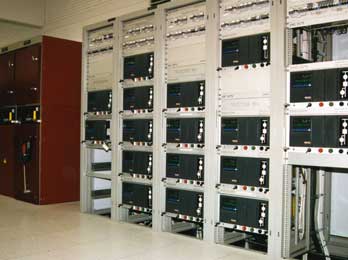
Field Test Procedure For Protective Relays
1. Relay Settings
At all new protective relay installations, the relays should be adjusted in accordance with the settings given in the relay data sheets, after which, tests should be made to determine if the actual operating characteristics check with the adjustments made. The Denver Office, Facilities Engineering Branch, must be advised of field changes of relay settings that become necessary from time to time as system operating conditions change to permit coordination with the Division of Design on future designs or revisions. Relays and relay settings are not to be changed from what is indicated on current issues of relay data sheets unless authorized by regional or project personnel with the proper responsibility.
.
2. Applying Revised Relay Settings
It is necessary to revise relay settings upward from time to time at many stations in preparation for anticipated increased unit output or line loading. At such times it may also be necessary to make corresponding changes in backup protective equipment in order to maintain coordination. Under these conditions, the changes in the backup relays should be made first so that coordination will not be lost during the period between beginning and completion of tests. This would apply whenever increased backup relay settings accompany changes in first-line protective equipment.
One case has been brought to our attention where new settings were applied to line relays but, because of lack of time, the backup ground relay was not reset until the following day. In the meantime, a fault occurred on the line, and the entire station was interrupted because the coordination had been lost. If the backup ground relay had been reset before settings were changed on line breaker relays, this interruption would not have occurred.
In a few rare cases relay settings may be revised downward at a station; and, in such cases, the opposite sequence must be followed in order to maintain coordination. When relay settings are revised downward, apply the new settings to the line breakers first and to the backup relays last.
.
3. New Installations
Before placing a new installation into operation, polarity of instrument transformers and the wiring to the relays should be checked. In some cases, the manufacturer’s polarity marking has been found to be incorrect. New relays should be inspected carefully and all blocking put in by the manufacturer removed. The test man should read instruction books furnished by the manufacturer to become familiar with construction and operating principle of the relays.
A sufficient number of initial operations should be made by manually operating relay contacts to make sure that all devices which should be operated by the relay, function freely and properly, including auxiliary contacts and targets within the relay. Breaker trip coils and other devices operated by the relay should be checked to see that proper operation is obtained at voltages considerably below normal (approximately 56 percent of normal voltage for breaker trip coils). The voltage drop in trip circuits and tripping current required should be checked. Factory adjustments on relays, other than taps, or other adjusting devices intended for customary adjustment should not be changed unless tests show that factory adjustments have been disturbed, in which case the manufacturers’ instruction books should be followed.
.
4. Testing Equipment Required
A good set of testing equipment and relay tools are important. Several manufacturers now produce portable relay test sets that will provided excellent results. If not available on the project, most of the equipment necessary can be borrowed from the Denver Office for making relay tests.
.
5. Testing Precautions
Before starting to test any relay on equipment in service, the person testing should become familiar with the relays and the circuits involved. Where test blocks are used, the person testing must make sure that in removing or inserting plugs that a current transformer circuit will not be opened, resulting in a voltage being built up which may be dangerous to personnel, property, or equipment, or cause an important circuit to trip out. In old installations where test blocks are not available, current transformer circuits must be short circuited by jumpers having reliable clamping devices which will not come loose, before the relay current circuit is opened.
.
6. Frequency Of Testing
It is recommended that protective and auxiliary relays be given a complete calibration test and inspection at least once a year. This schedule, however, sometimes cannot be met due to existing workloads and available manpower with the result that routine calibration tests intervals of many relays are longer than a year.
.
7. Test Records
A complete record should be kept of all test data and observations made during tests and inspections, including identifying numbers of test equipment used.
.
8. Annual Inspection
All relays shall be given an annual inspection. This inspection should include the following:
- A visual inspection should be made of all relays on a terminal including the tripping auxiliaries and accessories. Any drawout type relay should be withdrawn from its case for a closeup examination. All other, including auxiliaries, should at least have covers removed. Included in this visual inspection should be a check for loose connections, broken studs, burned insulation, and dirty contacts. Each relay should be checked to be in agreement with its setting sheet. On some distance relays it may have been necessary to set the taps on something other than specified values in order to get proper calibration. Because of this, it may also be necessary to check the taps against the last calibration test report.
- A test trip should be made of all relay systems. All relay elements which initiate some protective function should be checked. This includes reclosing, carrier starting, or any similar type function. After proving that tripping relays will successfully trip the circuit breaker and that all reclosing schemes work, continuity checks should be used, where applicable, to complete the checkout of the circuit breaker trip circuits.
.
9. Test Procedures
Tests to be performed during routine maintenance are determined by the type of relay to be tested. The following tests should be included for all electromechanical relays.
- A visual inspection of the relay cover can reveal valuable information. Any excessive dust, dirt, or. metallic material deposited on the cover should be noted and removed, thus preventing such material from entering the relay when the cover is removed. A cover glass which is fogged should be cleaned. Fogging is in most cases a normal condition due to volatile materials being driven out of coils and insulating materials, and is not an indication of a problem. However if fogging appears excessive, since most relays are designed to operate in ambient temperatures not exceeding 40EC (104EF), a further check of the ambient temperature would be in order. Voltage and current supplied to the relay should be checked and compared with the name plate or instruction book ratings. Should evidence of overheating be found, the insulation should be checked for embrittlement and, where necessary, replaced. Removal of the connection plug in drawout relays may reveal evidence of severe fault currents or contaminated atmospheres, either of which may indicate the advisability of a change in maintenance schedule. The condition of the relay contacts can be equally revealing.
- Mechanical adjustments and inspection should be made according to instructions shown following:
- Check to see that all connections are tight. Several loose connections could indicate excessive vibration which should be corrected.
- All gaps should be checked that they are freeof foreign material. If foreign material is found in the relay, the case gasket should be checked and replaced if necessary.
- All contact or armature gaps should bemeasured and values compared with previous measurements. Large variations in these measurements may indicate excessive wear, and worn parts should be replaced. Also an adjusting screw could have worked loose and must be tightened. All of this information should be noted on the test record.
- All contacts except those not recom-mended for maintenance should be burnished, and measured for alignment and wipe.
- Since checking bearings or pivotsusually involves dismantling the relay, it is recommended that such a test be made only when the relay appears to be extremely dirty, or when subsequent electrical tests indicate undue friction.
- Electrical tests and adjustments should be made according to the instructions shown following:
- Contact function.-Manually close oropen the contacts, and observe that they perform their required function; such as trip, reclose, or block.
- Pickup.-Gradually apply current or voltage to see that pickup is within limits. The current or voltage should be applied gradually in order to yield data which can be compared with previous or future tests and not be clouded by such effects as transient overreach.
- Dropout or reset.-To test for excessfriction, reduce current until the relay drops out or resets. Should the relay be sluggish in resetting or fail to reset, then the jewel bearing and pivot should be examined. A four power magnification is adequate for examining the pivot, and the jewel bearing can be examined with the aid of a needle which will reveal any cracks in it. If dirt is the problem, the jewel can be cleaned with an orange stick and the pivot can be wiped clean with a soft, lint free cloth. No lubricant should be used on either the jewel or pivot.
.
10. Auxiliary Relays
In addition to tests described in paragraph 9, auxiliary relays employing devices for time delay (for example, capacitors) should have an operating time test performed (either pickup or dropout, whichever is applicable).
.
11. Time Overcurrent And Time-Overvoltage Relays
All tests described in paragraph 9 should be performed for time-overcurrent and time-over-voltage relays where applicable. These types of relays should always be tested in the case in order to duplicate “in-service” conditions or to match published curves since the relay case normally acts as a shunt for flux that the electromagnetic iron circuit cannot handle due to saturation.
Testing the relay out of the case will also produce results that would not check previous tests or future tests since changes in test conditions, such as being near a steel cabinet, will change results obtained if the relay is tested out of the case. The first electrical test made on the relay should be a pickup test. Pickup is defined as that value of current or voltage which will just close the relay contacts from the
0.5 time-dial position. Allowing for such things asmeter differences and interpretations of readings, this value should be within ± 5 percent of previous data.
One or two points on the time-current curve are generally sufficient for maintenance purposes. Reset the relay to the original time-dial setting and check at two points such as 3 and 5 times pickup. Always use the same points for comparison with previous tests.
The instantaneous unit should be checked for pickup using gradually applied current. Whenever possible, current should be applied only to the instantaneous unit to avoid overheating the time unit. The target seal-in unit should also be tested using gradually applied current. The main unit contacts must be blocked closed for this test.
.
12. Directional Overcurrent Relays
In addition to tests recommended for the overcurrent relay, the directional unit of the directional overcurrent relay should be tested for minimum pickup, angle of maximum torque, contact gap, and clutch pressure. A test should also be made to check that the overcurrent unit operates only when the directional unit contacts are closed.
.
13. Distance Relays
When testing distance relays, tests should be made of pickup, angle of maximum torque, contact gap, and clutch pressure, in addition to the tests described in paragraph 9. (See appendix C for adjustment of Westinghouse Type KD relays).
.
14. Differential Relays
A test of minimum pickup should be performed for differential relays. The differential characteristic (slope) should be checked, and where applicable, the harmonic restraint should be tested. Differential relays using ultrasensitive polarized units as sensing devices are slightly affected by previous history, such as heavy internal or external fault currents. It is therefore recommended that for this type of relay two pickup readings be taken and the second reading be the one that is used for comparison with previous and future tests.
.
15. Static Relays
Static relays should be tested in accordance with manufacturer’s recommendations given in relay instruction books. As there are no moving parts in static relays, there is no physical wear due to usage and no need for lubricants. Prime causes of failure in electronic components are heat, vibration, and moisture. Overheating can be caused by voltage transients, current surges, excessive power, or high ambient temperature.
Vibration can loosen or break leads and connections and can crack component casings or insulation resulting in equipment failure. Moisture can result in corrosion of metallic elements which can result in circuit discontinuities, poor contact, or shorts. Preventive maintenance of static relays should be directed toward removing causes of failure listed above by doing the following:
- Keep equipment clean by periodic vacuuming or blowing out of dirt, dust, and other surface contaminants.
- Keep the equipment dry and protectedagainst moisture and corrosion.
- Inspect to see that all connections, leads,and contacts are tight and free as possible from effects of vibration.
- Check to see that there is adequateventilation to conduct heat away efficiently.
Preventive measures should not be applied unnecessarily as this may contribute to failures. For example, printed circuit cards should not be pulled from their racks to be inspected if there is no real need. Operating test switches unnecessarily may introduce damaging voltage transients.
.
16. Portable Relay Panels
Particular attention should be given to relays mounted on portable relay panels as these relays are subjected to more rough handling than those permanently installed on a switchboard. Therefore, whenever a portable panel of relays is installed, they should be thoroughly checked physically as well as electrically. If they are in bad condition, they should be repaired, or new relays installed before they are placed in service.
.
17. Circuit Burden Measurements For CT’S
When CT circuits are modified such as by addition of relays, meters, or auxiliary CT’s, measurements should be taken to determine the burden of the overall CT secondary circuit. These measurements should normally be on a phase-to-neutral basis. Measurements should be made at three current levels, such as 1, 3, and 5, while recording volts, amps, and phase angle. When auxiliary CT’s are involved, additional and separate measurements should be taken on the secondary circuit of the auxiliary CT’s.
.
18. Excitation Curves For CT’S
Auxiliary CT’s tend to saturate at much less secondary current and burden than large multi-ratio bushing type CT’s. Excitation curves should be available on all CT’s, especially on auxiliary CT’s used in protective relaying circuits (fig. 1). Such curves can be derived by open-circuiting the primary, and driving the secondary with a 60-Hertz source while measuring voltage and current. Readings should be taken up to two times rated secondary current or to the point where voltage applied is 1500 volts.
.
19. Grounding CT And PT Circuits
The CT and PT circuits should be grounded at only one point. Relay misoperations can be caused by grounding the neutral at two points, such as one ground at the switchyard and another at the relay panel. At least once every 3 years with the primary deenergized, the known ground should be removed and the overall circuits should be checked for additional grounds and insulation breakdowns.
.
20. Open-Secondary Circuits
WARNING: Secondary circuits of CT’s must not be open while primary current flows.
Extreme care should be taken to avoid breaking the secondary circuit while primary current is flowing. If the secondary is open-circuited the primary current raises core flux density to saturation and induces a high voltage in the secondary which can endanger human life, and can damage connected apparatus and leads. If it is necessary to change secondary conditions while primary current is flowing, the secondary terminals must be short-circuited while the change is being made. Caution should be exercised when working with differential circuits as shorting a current transformer in an energized differential relaying circuit could result in a relay operation.
It is recommended that the secondaries of all current transformers be kept short-circuited at all times when not installed in a circuit such as being held in stock or being transported.
.
21. Tempererature Relays
Temperature relays used on bearings and for other important purposes should be checked for correct operation by placing the bulb in a pail of water with a thermometer, and gradually heating to the temperature at which the relay is set to operate. A mercury or alcohol thermometer should be used to read the temperature while the water is being stirred.
Record temperature at which the relay operates on increasing temperature and at which it resets on falling temperature. Temperature relays operating from RTD’s (resistance temperature detectors) should be checked by heating the detectors slowly in an enclosed air space since they should not be immersed in water or other liquid.
.
22. Pressure Relays
Pressure relays should be checked for correct operation by comparing with an accurate pressure gage. Pressure should be increased and decreased to determine the pressure at which the relay operates and resets. The above does not apply to sudden pressure relays, which should be maintained in accordance with the manufacturer’s recommendations.
.
Related articles
- Line Protection With Distance Relays
- ABB Power Transformers – A guide to manufacturing
- High Voltage Substation Earth Grid Impedance Testing
- ABB Feeder Protection REF615 ANSI
- Procedure for the establishment of a new substation
9,914 views
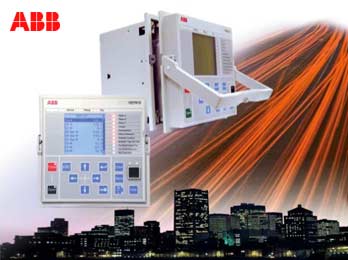
ABB Feeder Protection REF615 ANSI
The REF615 is powerful, most advanced and simplest feeder protection relay in its class, perfectly offering time and instantaneous overcurrent, negative sequence overcurrent, phase discontinuity, breaker failure and thermal overload protection. The relay also features optional high impedance fault (HIZ) and sensitive earth fault (SEF) protection for grounded and ungrounded distribution systems. Also, the relay incorporates a flexible three-phase multi-shot auto-reclose function for automatic feeder restoration in temporary faults on overhead lines. Enhanced with safety options, the relay offers a three-channel arc-fault detection system for supervision of the switchgear circuit breaker, cable and busbar compartments.
The REF615 also integrates basic control functionality, which facilitates the control of one circuit breaker via the relay’s front panel human machine interface (HMI) or remote control system. To protect the relay from unauthorized access and to maintain the integrity of information, the relay has been provided with a four-level, role-based user authentication system, with individual passwords for the viewer, operator, engineer and administrator level. The access control system applies to the front panel HMI, embedded web browser based HMI and the PCM600 relay setting and configuration tool.
Standardized communication
REF615 supports the new IEC 61850 standard for inter-device communication in substations. The relay also supports the industry standard DNP3.0 and Modbus® protocols.
The implementation of the IEC 61850 substation communication standard in REF615 encompasses both vertical and horizontal communication, including GOOSE messaging and parameter setting according to IEC 61850-8-1. The substation configuration language enables the use of engineering tools for automated configuration, commissioning and maintenance of substation devices.
Bus protection via GOOSE
The REF615 IEC 61850 implementation includes GOOSE messaging for fast horizontal relay-to-relay communication. Applying GOOSE communication to the REF615 relays of the incoming and outgoing feeders of a substation, a stable, reliable and high-speed bus protection system can be realized. The cost-effective GOOSE-based bus protection is obtained just by configuring the relays and the operational availability of the protection is assured by continuous supervision of the protection relays and their GOOSE messaging over the station communication network.
Costs are reduced since no separate physical input and output hard-wiring is needed for horizontal communication between the relays.

Bus protection via GOOSE
Pre-emptive condition monitoring
For continuous knowledge of the operational availability of the REF615 features, a comprehensive set of monitoring functions to supervise the relay health, the trip circuit and the circuit breaker health is included. The breaker monitoring can include checking the wear and tear of the circuit breaker, the spring charging time of the breaker operating mechanism and the gas pressure of the breaker chambers. The relay also monitors the breaker travel time and the number of circuit breaker (CB) operations to provide basic information for scheduling CB maintenance.
Rapid set-up and commissioning
Due to the ready-made adaptation of REF615 for the protection of feeders, the relay can be rapidly set up and commissioned, once it has been given the application- specific relay settings. If the relay needs to be adapted to the special requirements of the intended application, the flexibility of the relay allows the relay’s standard signal configuration to be adjusted by means of the signal matrix tool (SMT) included in its PCM600 relay setting and configuration user tool.
By means of Connectivity Packages containing complete descriptions of ABB’s protection relays, with data signals, parameters and addresses, the relays can be automatically configured via PCM600 relay setting and configuration user tool, COM600 Station Automation series devices, or MicroSCADA Pro substation automation system.
Unique draw-out design relay
The draw-out type relay design speeds up installation and testing of the protection. The factory-tested relay units can be withdrawn from the relay cases during factory and commissioning tests. The relay case provides automatic short-circuiting of the CT secondary circuits to prevent hazardous voltages from arising in the CT circuits when a relay plug-in unit is withdrawn from its case.
The pull-out handle locking the relay unit into its case can be sealed to prevent the unit from being unintentionally withdrawn from the relay case.
REF615 highlights
- Comprehensive overcurrent protection with high impedance fault, sensitive earth fault and thermal overload protection for feeder and dedicated protection schemes
- Simultaneous DN3.0 Level 2+ and Modbus Ethernet communications plus device connectivity and system interoperability according to the IEC 61850 standard for next generation substation communication
- Enhanced digital fault recorder functionality including high sampling frequency, extended length of records, 4 analog and 64 binary channels and flexible triggering possibilities
- High-speed, three-channel arc flash detection (AFD) for increased personal safety, reduced material damage and minimized system down-time
- Total control of the operational capability of the protection system through extensive condition monitoring of the relay and the associated primary equipment
- Draw-out type relay unit and a unique relay case design for a variety of mounting methods and fast installation, routine testing and maintenance
- One single tool for managing relay settings, signal configuration and disturbance handling
Analog inputs
- Three phase currents: 5/1 A
- Ground current: 5/1 A or 0.2 A
- Rated frequency: 60/50 Hz programmable
Binary inputs and outputs
- Four binary inputs with common ground
- Two NO double-pole outputs with TCM
- Two NO single-pole outputs
- One Form C signal output
- One Form C self-check alarm output
- Additional seven binary inputs plus three binary outputs (available as an option)
Communication
- IEC 61850-8-1 with GOOSE messaging
- DNP3.0 Level 2+ over TCP/IP
- Modbus over TCP/IP
- Time synchronization via SNTP (primary and backup servers)
- Optional serial RS-485 port programmable for DNP3.0 Level 2+ or Modbus RTU
Control voltage
- Option 1: 48 … 250 V dc, 100 … 240 V ac
- Option 2: 24 … 60 V dc
.
SOURCE: ABB
.
Related articles
- ANSI code 50BF – Breaker failure
- ANSI standards for protection devices
- Line Protection With Distance Relays
- Testing performances of IEC 61850 GOOSE messages
- Grounded or Ungrounded Systems
16,746 views
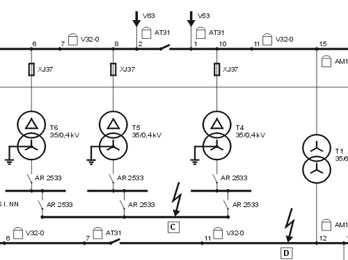
Adjustment Of Protection Relays Parameters
The successful operation of an MV distribution system depends on the proper selection and setting of switchgear relays.
Protective relays are arguably the least understood component of medium voltage (MV) circuit protection. In fact, somebelieve that MV circuit breakers operate by themselves, without direct initiation by protective relays. Others think that the operation and coordination of protective relays is much too complicated to understand. Let’s get into the details and eliminate these misbeliefs.
Background information
The IEEE Standard Dictionary defines a circuit breaker as follows:
A device designed to open and close a circuit by nonautomatic means, and to open the circuit automatically on a predetermined overload of current without injury to itself when properly applied within its rating.
By this definition, MV breakers are not true circuit breakers, since they do not open automatically on overcurrent. They are electrically operated power-switching devices, not operating until directed by some external device to open or close. This is true whether the unit is an air, oil, vacuum, or [SF.sub.6] circuit breaker. Sensors and relays are used to detect the overcurrent or other abnormal or unacceptable condition and to signal the switching mechanism to operate. The MV circuit breakers are the brute-force switches while the sensors and relays are the brains that direct their functioning.
The sensors can be current transformers (CTs), potential transformers (PTs), temperature or pressure instruments, float switches, tachometers, or any device or combination of devices that will respond to the condition or event being monitored. In switchgear application, the most common sensors are CTs to measure current and PTs to measure voltage. The relays measure sensor output and cause the breaker to operate to protect the system when preset limits are exceeded, hence the name “protective relays.” The availability of a variety of sensors, relays, and circuit breakers permits the design of complete protection systems as simple or as complex as necessary, desirable, and economically feasible.
Electromechanical relays
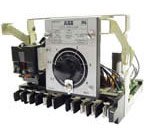
Electromechanical relay
For many years, protective relays have been electromechanical devices, built like fine watches, with great precision and often with jeweled bearings. They have earned a well-deserved reputation for accuracy, dependability, and reliability. There are two basic types of operating mechanisms: the electromagnetic-attraction relay and the electromagnetic-induction relay.
Magnetic attraction relays. Magnetic-attraction relays, have either a solenoid that pulls in a plunger, or one or more electromagnets that attract a hinged armature. When the magnetic force is sufficient to overcome the restraining spring, the movable element begins to travel, and continues until the contact(s) close or the magnetic force is removed. The pickup point is the current or voltage at which the plunger or armature begins to move and, in a switchgear relay, the pickup value can be set very precisely.
These relays are usually instantaneous in action, with no intentional time delay, closing as soon after pickup as the mechanical motion permits. Time delay can be added to this type of relay by means of a bellows, dashpot, or a clockwork escapement mechanism. However, timing accuracy is considerably less precise than that of induction-type relays, and these relays are seldom used with time delay in switchgear applications.
Attraction-type relays can operate with either AC or DC on the coils; therefore, relays using this principle are affected by the DC component of an asymmetrical fault and must be set to allow for this.
Induction relays. Induction relays, are available in many variations to provide accurate pickup and time-current responses for a wide range of simple or complex system conditions. Induction relays are basically induction motors. The moving element, or rotor, is usually a metal disk, although it sometimes may be a metal cylinder or cup. The stator is one or more electromagnets with current or potential coils that induce currents in the disk, causing it to rotate. The disk motion is restrained by a spring until the rotational forces are sufficient to turn the disk and bring its moving contact against the stationary contact, thus closing the circuit the relay is controlling. The greater the fault being sensed, the greater the current in the coils, and the faster the disk rotates.
A calibrated adjustment, called the time dial, sets the spacing between the moving and stationary contacts to vary the operating time of the relay from fast (contacts only slightly open) to slow (contacts nearly a full disk revolution apart). Reset action begins when the rotational force is removed, either by closing the relay contact that trips a breaker or by otherwise removing the malfunction that the relay is sensing. The restraining spring resets the disk to its original position. The time required to reset depends on the type of relay and the time-dial setting (contact spacing).
With multiple magnetic coils, several conditions of voltage and current can be sensed simultaneously. Their signals can be additive or subtractive in actuating the disk. For example, a current-differential relay has two current coils with opposing action. If the two currents are equal, regardless of magnitude, the disk does not move. If the difference between the two currents exceeds the pickup setting, the disk rotates slowly for a small difference and faster for a greater difference. The relay contacts close when the difference continues for the length of time determined by the relay characteristics and settings. Using multiple coils, directional relays can sense direction of current or power flow, as well as magnitude. Since the movement of the disk is created by induced magnetic fields from AC magnets, induction relays are almost completely unresponsive to the DC component of an asymmetrical fault.
Most switchgear-type relays are enclosed in a semiflush-mounting drawout case. Relays usually are installed on the door of the switchgear cubicle. Sensor and control wiring are brought to connections on the case. The relay is inserted into the case and connected by means of small switches or abridging plug, depending on the manufacturer. It can be disconnected and withdrawn from the case without disturbing the wiring. When the relay is disconnected, the CT connections in the case are automatically shorted to short circuit the CT secondary winding and protect the CT from overvoltages and damage.
Many relays are equipped with a connection for a test cable. This permits using a test set to check the relay calibration. The front cover of the relay is transparent, can be removed for access to the mechanism, and has provisions for wire and lead seals to prevent tampering by unauthorized personnel.
Solid-state relays
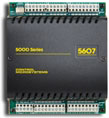
Solid state relay
Recently, solid-state electronic relays have become more popular. These relays can perform all the functions that can be performed by electromechanical relays and, because of the versatility of electronic circuitry and microprocessors, can provide many functions not previously available. In general, solid-state relays are smaller and more compact than their mechanical equivalents. For example, a 3-phase solid-state overcurrent relay can be used in place of three single-phase mechanical overcurrent relays, yet is smaller than one of them.
The precision of electronic relays is greater than that of mechanical relays, allowing closer system coordination. In addition, because there is no mechanical motion and the electronic circuitry is very stable, they retain their calibration accuracy for a long time. Reset times can be extremely short if desired because there is no mechanical motion.
Electronic relays require less power to operate than their mechanical equivalents, producing a smaller load burden on the CTs and PTs that supply them. Because solid-state relays have a minimum of moving parts, they can be made very resistant to seismic forces and are therefore especially well suited for areas susceptible to earthquake activity.
In their early versions, some solid-state relays were sensitive to the severe electrical environment of industrial applications. They were prone to failure, especially from high transient voltages caused by lightning or utility and on-site switching. However, today’s relays have been designed to withstand these transients and other rugged application conditions, and this type of failure has essentially been eliminated. Solid-state relays have gained a strong and rapidly growing position in the marketplace as experience proves their accuracy, dependability, versatility, and reliability.
The information that follows applies to electromechanical and solid-state relays, although one functions mechanically and the other electronically. Significant differences will be pointed out.
Relay types
There are literally hundreds of different types of relays. The catalog of one manufacturer of electromechanical relays lists 264 relays for switchgear and system protection and control functions. For complex systems with many voltage levels and interconnections over great distances, such as utility transmission and distribution, relaying is an art to which some engineers devote their entire careers. For more simple industrial and commercial distribution, relay protection can be less elaborate, although proper selection and application are still very important.
The most commonly used relays and devices are listed HERE in the Table by their American National Standards Institute (ANSI) device-function number and description. These standard numbers are used in one-line and connection diagrams to designate the relays or other devices, saving space and text.
Where a relay combines two functions, the function numbers for both are shown. The most frequently used relay is the overcurrent relay, combining both instantaneous and inverse-time tripping functions. This is designated device 50/51. As another example, device 27/59 would be a combined undervoltage and overvoltage relay. The complete ANSI standard lists 99 device numbers, a few of which are reserved for future use.
Relays can be classified by their operating-time characteristics. Instantaneous relays are those with no intentional time delay. Some can operate in one-half cycle or less; others may take as long as six cycles. Relays that operate in three cycles or less are called high-speed relays.
Time-delay relays can be definite-time or inverse-time types. Definite-time relays have a preset time delay that is not dependent on the magnitude of the actuating signal (current, voltage, or whatever else is being sensed) once the pickup value is exceeded. The actual preset time delay is usually adjustable.
Inverse-time relays, such as overcurrent or differential relays, have operating times that do depend on the value of actuating signal. The time delay is long for small signals and becomes progressively shorter as the value of the signal increases. The operating time is inversely proportional to the magnitude of the event being monitored.
Overcurrent relays
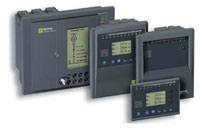
Sepam protection relay
In switchgear application, an overcurrent relay usually is used on each phase of each circuit breaker and often one additional overcurrent relay is used for ground-fault protection. Conventional practice is to use one instantaneous short-circuit element and one inverse-time overcurrent element (ANSI 50/51) for each phase.
In the standard electromechanical relay, both elements for one phase are combined in one relay case. The instantaneous element is a clapper or solenoid type and the inverse-time element is an induction-disk type.
In some solid-state relays, three instantaneous and three inverse-time elements can be combined in a single relay case smaller than that of one induction-disk relay.
Overcurrent relays respond only to current magnitude, not to direction of current flow or to voltage. Most relays are designed to operate from the output of a standard ratio-type CT, with 5A secondary current at rated primary current. A solid-state relay needs no additional power supply, obtaining the power for its electronic circuitry from the output of the CT supplying the relay.
On the instantaneous element, only the pickup point can be set, which is the value of current at which the instantaneous element will act, with no intentional time delay, to close the trip circuit of the circuit breaker. The actual time required will decrease slightly as the magnitude of the current increases, from about 0.02 sec maximum to about 0.006 sec minimum, as seen from the instantaneous curve. This time will vary with relays of different ratings or manufacturers and also will vary between electromechanical and solid-state relays.
Time delays can be selected over a wide range for almost any conceivable requirement. Time-delay selection starts with the choice of relay. There are three time classifications: standard, medium, and long time delay. Within each classification, there are three classes of inverse-time curve slopes: inverse (least steep), very inverse (steeper), and extremely inverse (steepest). The time classification and curve slopes are characteristic of the relay selected, although for some solid-state relays these may be adjustable to some degree. For each set of curves determined by the relay selection, the actual response is adjustable by means of the time dial.
On the inverse-time element, there are two settings. First the pickup point is set. This is the value of current at which the timing process begins as the disk begins to rotate on an electromechanical relay or the electronic circuit begins to time out on a solid-state relay.
Next the time-dial setting is selected. This adjusts the time-delay curve between minimum and maximum curves for the particular relay. A given relay will have only one set of curves, either inverse, very inverse, or extremely inverse, adjustable through the full time-dial range. Note that the current is given in multiples of pickup setting.
Each element, instantaneous or time delay, has a flag that indicates when that element has operated. This flag must be reset manually after relay operation.
Setting the pickup point
The standard overcurrent relay is designed to operate from a ratio-type CT with a standard 5A secondary output. The output of the standard CT is 5A at the rated nameplate primary current, and the output is proportional to the primary current over a wide range. For example, a 100/5 ratio CT would have a 5A output when the primary current (the current being sensed and measured) is 100A. This primary-to-secondary ratio of 20-to-1 is constant so that for a primary current of 10A, the secondary current would 0.5A; for 20A primary, 1.0A secondary; for 50A primary, 2.5A secondary; etc. For 1000A primary, the secondary current is 50A, and similarly for all values of current up to the maximum that the CT will handle before it saturates and becomes nonlinear.
The first step in setting the relay is selecting the CT so that the pickup can be set for the desired primary current value. The primary current rating should be such that a primary current of 110 to 125% of the expected maximum load will produce the rated 5A secondary current. The maximum available primary fault current should not produce more than 100A secondary current to avoid saturation and excess heating. It may not be possible to fulfill these requirements exactly, but they are useful guidelines. As a result, some compromise may be necessary.
On the 50/51 overcurrent relay, the time-overcurrent-element (device 51) setting is made by means of a plug or screw inserted into the proper hole in a receptacle with a number of holes marked in CT secondary amperes, by an adjustable calibrated lever or by some similar method. This selects one secondary current tap (the total number of taps depends on the relay) on the pickup coil. The primary current range of the settings is determined by the ratio of the CT selected.
For example, assume that the CT has a ratio of 50/5A. Typical taps will be 4, 5, 6, 7, 8, 10, 12, and 16A. The pickup settings would range from a primary current of 40A (the 4A tap) to 160A (the 16A tap). If a 60A pickup is desired, the 6A tap is selected. If a pickup of more than 160A or less than 40A is required, it would be necessary to select a CT with a different ratio or, in some cases, a different relay with higher or lower tap settings.
Various types of relays are available with pickup coils rated as low as 1.5A and as high as 40A. Common coil ranges are 0.5 to 2A, for low-current pickup such as ground-fault sensing; 1.5 to 6A medium range; or 4 to 16A, the range usually chosen for overcurrent protection. CTs are available having a wide range of primary ratings, with standard 5A secondaries or with other secondary ratings, tapped secondaries, or multiple secondaries.
A usable combination of CT ratio and pickup coil can be found for almost any desired primary pickup current and relay setting.
The instantaneous trip (device 50) setting is also adjustable. The setting is in pickup amperes, completely independent of the pickup setting of the inverse-time element or, on some solid-state relays, in multiples of the inverse-time pickup point. For example, one electromechanical relay is adjustable from 2 to 48A pickup; a solid-state relay is adjustable from 2 to 12 times the setting of the inverse-time pickup tap. On most electromechanical relays, the adjusting means is a tap plug similar to that for the inverse-time element. With the tap plug, it is possible to select a gross current range. An uncalibrated screw adjustment provides final pickup setting. This requires using a test set to inject calibration current into the coil if the setting is to be precise. On solid-state relays, the adjustment may be a calibrated switch that can be set with a screwdriver.
Setting the time dial
For any given tap or pickup setting, the relay has a whole family of time-current curves. The desired curve is selected by rotating a dial or moving a lever. The time dial or lever is calibrated in arbitrary numbers, between minimum and maximum values, as shown on curves published by the relay manufacturer. At a time-dial setting of zero, the relay contacts are closed. As the time dial setting is increased, the contact opening becomes greater, increasing relay operating time. Settings may be made between calibration points, if desired, and the applicable curve can be interpolated between the printed curves.
The pickup points and time-dial settings are selected so that the relay can perform its desired protective function. For an overcurrent relay, the goal is that when a fault occurs on the system, the relay nearest the fault should operate. The time settings on upstream relays should delay their operation until the proper overcurrent device has cleared the fault. A selectivity study, plotting the time-current characteristics of every device in that part of the system being examined, is required. With the wide selection of relays available and the flexibility of settings for each relay, selective coordination is possible for most systems.
Selecting and setting other than overcurrent relays are done in similar fashion. Details will vary, depending on the type of relay, its function in the system, and the relay manufacturer.
Relay operation
An electromechanical relay will pick up and start to close its contacts when the current reaches the pickup value. At the inverse-time pickup current, the operating forces are very low and timing accuracy is poor. The relay timing is accurate at about 1.5 times pickup or more, and this is where the time-current curves start. This fact must be considered when selecting and setting the relay.
When the relay contacts close, they can bounce, opening slightly and creating an arc that will burn and erode the contact surfaces. To prevent this, overcurrent relays have an integral auxiliary relay with a seal-in contact in parallel with the timing relay contacts that closes immediately when the relay contacts touch. This prevents arcing if the relay contacts bounce. This auxiliary relay also activates the mechanical flag that indicates that the relay has operated.
When the circuit breaker being controlled by the relay opens, the relay coil is deenergized by an auxiliary contact on the breaker. This protects the relay contacts, which are rated to make currents up to 30A but should not break the inductive current of the breaker tripping circuit, to prevent arcing wear. The disk is then returned to its initial position by the spring. The relay is reset. Reset time is the time required to return the contacts fully to their original position. Contacts part about 0.1 sec (six cycles) after the coil is deenergized. The total reset time varies with the relay type and the time-dial setting. For a maximum time-dial setting (contacts fully open), typical reset times might be 6 sec for an inverse-time relay and up to 60 sec for a very inverse or extremely inverse relay. At lower time-dial settings, contact opening distance is less, therefore reset time is lower.
A solid-state relay is not dependent on mechanical forces or moving contacts for its operation but performs its functions electronically. Therefore, the timing can be very accurate even for currents as low as the pickup value. There is no mechanical contact bounce or arcing, and reset times can be extremely short.
CT and PT selection
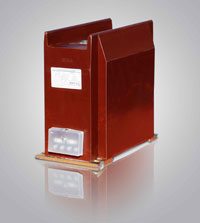
MV current transformer
In selecting instrument transformers for relaying and metering, a number of factors must be considered; transformer ratio, burden, accuracy class, and ability to withstand available fault currents.
CT ratio. CT guidelines mentioned earlier are to have rated secondary output at 110 to 125% of expected load and no more than 100A secondary current at maximum primary fault current. Where more than one CT ratio may be required, CTs with tapped secondary windings or multi-winding secondaries are available.
CT burden. CT burden is the maximum secondary load permitted, expressed in voltamperes (VA) or ohms impedance, to ensure accuracy. ANSI standards list burdens of 2.5 to 45VA at 90% power factor (PF) for metering CTs, and 25 to 200VA at 50% PF for relaying CTs.
CT accuracy class. ANSI accuracy class standards are [+ or -] 0.3, 0.6, or 1.2%. Ratio errors occur because of [I.sup.2]R heating losses. Phase-angle errors occur because of magnetizing core losses.
CTs are marked with a dot or other polarity identification on primary and secondary windings so that at the instant current is entering the marked primary terminal it is leaving the marked secondary terminal. Polarity is not required for overcurrent sensing but is important for differential relaying and many other relaying functions.
PT ratio. PT ratio selection is relatively simple. The PT should have a ratio so that, at the rated primary voltage, the secondary output is 120V. At voltages more than 10% above the rated primary voltage, the PT will be subject to core saturation, producing voltage errors and excess heating.
PT burden. PTs are available for burdens from 12.5VA at 10% PF to as high as 400VA at 85% PF.
PT accuracy. Accuracy classes are ANSI standard [+ or -] 0.3, 0.6, or 1.2%. PT primary circuits, and where feasible PT secondary circuits as well, should be fused.
CTs and PTs should have adequate capacity for the burden to be served and sufficient accuracy for the functions they are to perform. However, more burden or accuracy than necessary will merely increase the cost of the metering transformers. Solid-state relays usually impose lower burdens than electromechanical relays.
Izvor: www.ecmweb.com
.
Related articles
- ABB Feeder Protection REF615 ANSI
- ANSI/IEC Relay Symbols
- ANSI standards for protection devices
- Line Protection With Distance Relays
- Arc-resistant low voltage switchgear
61,931 views
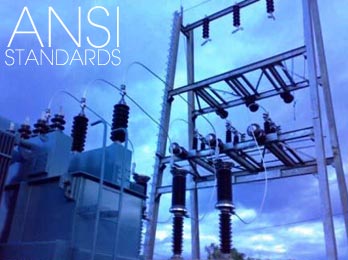
ANSI Functions For Protection Devices
In the design of electrical power systems, the ANSI Standard Device Numbers denote what features a protective device supports (such as a relay or circuit breaker). These types of devices protect electrical systems and components from damage when an unwanted event occurs, such as an electrical fault.
ANSI numbers are used to identify the functions of meduim voltage microprocessor devices.
ANSI facilitates the development of American National Standards (ANS) by accrediting the procedures of standards developing organizations (SDOs). These groups work cooperatively to develop voluntary national consensus standards. Accreditation by ANSI signifies that the procedures used by the standards body in connection with the development of American National Standards meet the Institute’s essential requirements for openness, balance, consensus and due process.
Current protection functions
ANSI 50/51 – Phase overcurrent
Three-phase protection against overloads and phase-to-phase short-circuits.
ANSI index ↑
ANSI 50N/51N or 50G/51G – Earth fault
Earth fault protection based on measured or calculated residual current values:
- ANSI 50N/51N: residual current calculated or measured by 3 phase current sensors
- ANSI 50G/51G: residual current measured directly by a specific sensor
ANSI 50BF – Breaker failure
If a breaker fails to be triggered by a tripping order, as detected by the non-extinction of the fault current, this backup protection sends a tripping order to the upstream or adjacent breakers.
ANSI index ↑
ANSI 46 – Negative sequence / unbalance
Protection against phase unbalance, detected by the measurement of negative sequence current:
- sensitive protection to detect 2-phase faults at the ends of long lines
- protection of equipment against temperature build-up, caused by an unbalanced power supply, phase inversion or loss of phase, and against phase current unbalance
ANSI 49RMS – Thermal overload
Protection against thermal damage caused by overloads on machines (transformers, motors or generators).
The thermal capacity used is calculated according to a mathematical model which takes into account:
- current RMS values
- ambient temperature
- negative sequence current, a cause of motor rotor temperature rise
Recloser
ANSI 79
Automation device used to limit down time after tripping due to transient or semipermanent faults on overhead lines. The recloser orders automatic reclosing of the breaking device after the time delay required to restore the insulation has elapsed. Recloser operation is easy to adapt for different operating modes by parameter setting.
ANSI index ↑
Directional current protection
ANSI 67N/67NC type 1
ANSI 67 – Directional phase overcurrent
Phase-to-phase short-circuit protection, with selective tripping according to fault current direction. It comprises a phase overcurrent function associated with direction detection, and picks up if the phase overcurrent function in the chosen direction (line or busbar) is activated for at least one of the 3 phases.
ANSI index ↑
ANSI 67N/67NC – Directional earth fault
Earth fault protection, with selective tripping according to fault current direction.
3 types of operation:
- type 1: the protection function uses the projection of the I0 vector
- type 2: the protection function uses the I0 vector magnitude with half-plane tripping zone
- type 3: the protection function uses the I0 vector magnitude with angular sector tripping zone
ANSI 67N/67NC type 1
Directional earth fault protection for impedant, isolated or compensated neutralsystems, based on the projection of measured residual current.
ANSI index ↑
ANSI 67N/67NC type 2
Directional overcurrent protection for impedance and solidly earthed systems, based on measured or calculated residual current. It comprises an earth fault function associated with direction detection, and picks up if the earth fault function in the chosen direction (line or busbar) is activated.
ANSI index ↑
ANSI 67N/67NC type 3
Directional overcurrent protection for distribution networks in which the neutral earthing system varies according to the operating mode, based on measured residual current. It comprises an earth fault function associated with direction detection (angular sector tripping zone defined by 2 adjustable angles), and picks up if the earth fault function in the chosen direction (line or busbar) is activated.
ANSI index ↑
Directional power protection functions
ANSI 32P – Directional active overpower
Two-way protection based on calculated active power, for the following applications:
- active overpower protection to detect overloads and allow load shedding
- reverse active power protection:
- against generators running like motors when the generators consume active power
- against motors running like generators when the motors supply active power
ANSI 32Q/40 – Directional reactive overpower
Two-way protection based on calculated reactive power to detect field loss on synchronous machines:
- reactive overpower protection for motors which consume more reactive power with field loss
- reverse reactive overpower protection for generators which consume reactive power with field loss.
Machine protection functions
ANSI 37 – Phase undercurrent
Protection of pumps against the consequences of a loss of priming by the detection of motor no-load operation.
It is sensitive to a minimum of current in phase 1, remains stable during breaker tripping and may be inhibited by a logic input.
ANSI index ↑
ANSI 48/51LR/14 – Locked rotor / excessive starting time
Protection of motors against overheating caused by:
- excessive motor starting time due to overloads (e.g. conveyor) or insufficient supply voltage.
The reacceleration of a motor that is not shut down, indicated by a logic input, may be considered as starting. - locked rotor due to motor load (e.g. crusher):
- in normal operation, after a normal start
- directly upon starting, before the detection of excessive starting time, with detection of locked rotor by a zero speed detector connected to a logic input, or by the underspeed function.
ANSI 66 – Starts per hour
Protection against motor overheating caused by:
- too frequent starts: motor energizing is inhibited when the maximum allowable number of starts is reached, after counting of:
- starts per hour (or adjustable period)
- consecutive motor hot or cold starts (reacceleration of a motor that is not shut down, indicated by a logic input, may be counted as a start)
- starts too close together in time: motor re-energizing after a shutdown is only allowed after an adjustable waiting time.
ANSI 50V/51V – Voltage-restrained overcurrent
Phase-to-phase short-circuit protection, for generators. The current tripping set point is voltage-adjusted in order to be sensitive to faults close to the generator which cause voltage drops and lowers the short-circuit current.
ANSI index ↑
ANSI 26/63 – Thermostat/Buchholz
Protection of transformers against temperature rise and internal faults via logic inputs linked to devices integrated in the transformer.
ANSI index ↑
ANSI 38/49T – Temperature monitoring
Protection that detects abnormal temperature build-up by measuring the temperature inside equipment fitted with sensors:
- transformer: protection of primary and secondary windings
- motor and generator: protection of stator windings and bearings.
Voltage protection functions
ANSI 27D – Positive sequence undervoltage
Protection of motors against faulty operation due to insufficient or unbalanced network voltage, and detection of reverse rotation direction.
ANSI index ↑
ANSI 27R – Remanent undervoltage
Protection used to check that remanent voltage sustained by rotating machines has been cleared before allowing the busbar supplying the machines to be re-energized, to avoid electrical and mechanical transients.
ANSI index ↑
ANSI 27 – Undervoltage
Protection of motors against voltage sags or detection of abnormally low network voltage to trigger automatic load shedding or source transfer.
Works with phase-to-phase voltage.
ANSI index ↑
ANSI 59 – Overvoltage
Detection of abnormally high network voltage or checking for sufficient voltage to enable source transfer. Works with phase-to-phase or phase-to-neutral voltage, each voltage being monitored separately.
ANSI index ↑
ANSI 59N – Neutral voltage displacement
Detection of insulation faults by measuring residual voltage in isolated neutral systems.
ANSI index ↑
ANSI 47 – Negative sequence overvoltage
Protection against phase unbalance resulting from phase inversion, unbalanced supply or distant fault, detected by the measurement of negative sequence voltage.
ANSI index ↑
Frequency protection functions
ANSI 81H – Overfrequency
Detection of abnormally high frequency compared to the rated frequency, to monitor power supply quality.
ANSI index ↑
ANSI 81L – Underfrequency
Detection of abnormally low frequency compared to the rated frequency, to monitor power supply quality. The protection may be used for overall tripping or load shedding. Protection stability is ensured in the event of the loss of the main source and presence of remanent voltage by a restraint in the event of a continuous decrease of the frequency, which is activated by parameter setting.
ANSI index ↑
ANSI 81R – Rate of change of frequency
Protection function used for fast disconnection of a generator or load shedding control. Based on the calculation of the frequency variation, it is insensitive to transient voltage disturbances and therefore more stable than a phase-shift protection function.
Disconnection
In installations with autonomous production means connected to a utility, the “rate of change of frequency” protection function is used to detect loss of the main system in view of opening the incoming circuit breaker to:
- protect the generators from a reconnection without checking synchronization
- avoid supplying loads outside the installation.
Load shedding
The “rate of change of frequency” protection function is used for load shedding in combination with the underfrequency protection to:
- either accelerate shedding in the event of a large overload
- or inhibit shedding following a sudden drop in frequency due to a problem that should not be solved by shedding.
Related book: Relay selection guide
Link: Register
Autor: Edvard Csanyi, CsanyiGroup
.
Related articles
- ABB Feeder Protection REF615 ANSI
- ANSI/IEC Relay Symbols
- Arc-resistant low voltage switchgear
- Protection relays – important informations
- Line Protection With Distance Relays





